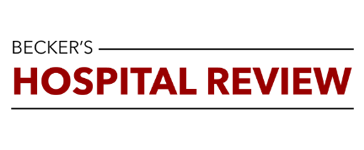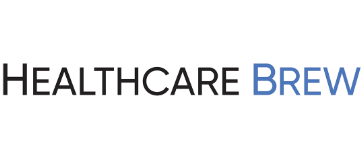On March 10th, Advantus President, Dan Hurry was featured on Modern Healthcare’s Supply Chain/Revenue Cycle Virtual Briefing.
His keynote session covered the evolution of supply chain to unveil the decision of why Advantus Health Partners decided to go independent, stripping away from traditional support and paving a path that goes beyond for our patients and caregivers. See the full transcript below.
Advantus Dan Hurry Keynote Transcript
[00:00:00] Dan Hurry: Thank you for having me today, Fon. Really appreciate the opportunity to share the journey of Advantus and what doers versus sayers really means to us. So, first off, I thought I’d give a little bit of a background about myself, my history in supply chain and what led us to Advantus Health Partners in what we’re doing today.
[00:00:26] So if I look at the history lesson I’ve been in supply chain, nearly 30 plus years now, I’ve had the blessing of working in manufacturing, working in retail, working in oil and gas and a little bit within each of those aspects. That is, it revolves around marketing, supply chain, production, product development, and other things.
[00:00:45] And in that opportunity, I learned a lot. So, as I moved forward in my career when I was in Texas, unfortunately, or fortunately, it’s kind of a blessing and a curse put together, I went through the experience of being diagnosed with cancer. And when I was diagnosed with cancer, one of the things that was interesting to me was the disconnect that I experienced between the physicians, the diagnosis, and ultimately the treatment that would take place. During that experience it, and what would be the longest vacation I’ve ever taken in my life, if we could put it that way, I reflected a lot about what to do in the future. Because I had the blessing of the world that I was working in to the opportunity across the whole country and working on various projects and would fly around and corporate jets working on product development or working on things such as innovation, and really had the whiteboard to just create whatever might be added value to folks and our clients and our customers that we had at the time.
[00:01:53] But going through that transition of the diagnosis and the experience that I went through, and it started like this really the doc comes in and he came in with more people than he originally started with. And at that point I knew it might be something interesting shared with me this statement.
[00:02:13] Unfortunately, the biopsy came back that you have cancer. And unfortunately, I’m not sure what to do with it. It’s in a unique place. It’s a unique form and we don’t know who to get ahold of, but we are going to go start to do some research and understand it. And then over the next few days, after working with five different physicians and trying to identify what to do next, we finally did find, the right physician out of Houston, Texas.
[00:02:40] Who did, come to San Antonio where I was, and then diagnosed. And then over the next few months, that’s when the vacation took place. During that time, it was very interesting to me to go through the experience because my experience today had been in production, been in manufacturing, been in a lot of different aspects of product development and connecting the dots across the continental U.S. with very complex projects.
[00:03:09] We’re very complex developments and really always saw the pathway to how to complete a project, how to get things from point A to point B to C D and all the way through the line to completion. When you go through an experience like that is as folks certainly have in this industry, there’s never really any clear answer
[00:03:32] There’s never really any clear pathway. And to me, it made me scratch my head and want to get involved. I wasn’t sure how or what and what when to do this, but I certainly repositioned my mind on what I wanted to do and get out of maybe product development, supply chain, core elements of development and the things that I did outside of the world I lived in, where it was product.
[00:03:57] It was fuel. It was moving things from point A to point B, but quite frankly, started to have more of an empty feeling of what was I doing for people at the end of the day. So, with that, I started to learn more about health care. I got more of an education of what was happening through my personal experience and then through talking with different folks.
[00:04:16] And as the good Lord would have it. Not too long after that, I had a discussion with the Chief Medical Officer of Baptist Health System in San Antonio, Texas, who essentially said to me, the crazy logistic stuff that you do over where you are today. Can you bring that into health care? To which I said, absolutely.
[00:04:36] I don’t really know what goes on there. I will tell you, I now have a passion. I have a different goal. I have a different pathway. I believe that’s been handed to me. So, I’m in. But I don’t know what we’re going to do. So, after a discussion with the leadership team there, we jumped in and I became the Vice President of Supply Chain for Baptist Health System, San Antonio.
[00:04:59] Quickly now I’m in health care and I’m going to give a little bit of day one experience. Literally day one sat with a group of physicians for a KOL management meeting and peripheral vascular products. And it was baffling to me to sit in the room and listen to physicians. And the administrative team struggle so much with what was being consumed. And their cases in the surgeries that were taking place all the way from the, what I’d say, commodity type products through implants and the standardization they were shooting for within the dynamics of that particular service line. I could not understand why we didn’t already have that info, number one. Number two, why it seemed to be in the room, listening to the dialogue, going on, such a struggle to gather what seemed to be very simple information.
[00:05:52] Keeping in mind, the world I came from, which certainly does not play into the same complexity or efficacy that we’ve got in health care. But we knew within a point of sale unit or a checkout unit, if you will, within four feet, how we could change behavior and what would be consumed by different consumers that would come in all day, every day. We never even questioned the ability to get the info.
[00:06:18] It was more a question of what would we do with the info. So, I got on the whiteboard that day. Mapped out what we should do to which the physician said that would be incredible is that’s all we got to do is get all the insights, map out the physicians on one axis, and then we can have some dialogue around how to standardize, how to optimize, how to move into the next phase of what we want to do here.
[00:06:40] Little did I know. That my team, the administrative team, while they’re not in their heads, as I just met them that day that they’ll get this done. It was actually a task that, that could not take place in, in the manner by which we did it.
[00:06:54] Well, then the journey from there continued on. So, as I think about the journey of Advantus we’ll step into that.
[00:07:00] How does this play into where we go from here? Because in those early days of health care, there’s really two things that I walked away with. One, I was completely baffled that the disconnect and the technology was as farfetched as it is and understanding consistency. And I’m going to give an example of where I came from and what I expected in health care.
[00:07:21] So this is just a Kind bar, but I will tell you the secret sauce within this is actually the UPC code. So, if you think about a UPC code, universal product code, that is something that exists, whether you’re in clothing, whether you’re in electronics, whether you’re in grocery, whether you’re in convenience, whatever channel you’re in, if you think about it.
[00:07:43] And you’ve never, probably had to think about it. As you go out and buy goods every day. That is what connects intelligence to the supplier base. It connects intelligence to the consumer, to the retailer and how the e-commerce really takes place all day, every day. You go through scanners at the end of the register that they ended the checkout.
[00:08:04] Now, as we’ve evolved in today’s technology through Amazon, they’re still using the universal product code. Now what’s interesting to me is you’ve got products like this. This is a pacemaker. Right. It’s small. Now this is, and I’m going to come back to this in a few minutes, but there’s no universal product code.
[00:08:22] When we think about the medical device industry. When we think about medical commodities, when we think about universal language in the digital supply chain side of the world and health care, unfortunately it’s not as complex as rigid and certainly not as consistent as it is in the retail world.
[00:08:41] And I would argue all day long that there’s more importance in those type products, how we care for people, how we heal people, how we bring people to a better place than it is in getting a candy bar or some other goods that we want a TV, you name it. We’ve got great complexity there, but we don’t bring it to the health care world. I’ve said in different settings.
[00:09:04] I, you know, I don’t know that we’ll ever get there, you know, in my time, you know, within this industry, but there’s ways that we can manage around that and understand that because it’s not a matter of the technical capabilities to do that. But naturally there’s a political dynamic that pushes against the ability to be consistent and universal product codes within the medical world and the consistency we bring there.
[00:09:27] So what does all that mean? Where do we go? How do we use that? This is where, when we think about that journey is how to bring in, you know, the outside intelligence to a future state of supply chain and health care. And how do we lift up and elevate what is absolutely a complex and if you think about it over the last few years, very forefront in the headlines and the news of what the challenges are in and supply chain as a whole. And what the challenges are in supply chain, within health care as a segment within that.
[00:10:01] We’ll talk about now is actually moving into what I’m going to say, how to tie in both the digital and the physical side of supply chain.
[00:10:09] I’m going to go back to the two examples that I have here as well. So back to the UPC, while it’s very important for the retailer or the consumer, to understand that, to go pay for it, scan it through the register it is equally important for the relationship between the buyer. In this case, I would say like that retail outlet.
[00:10:30] That chain of stores or whatever it might be and the manufacturer, because they use this language to determine demand planning, to determine what raw goods they need to bring together, how much they need when they need it. When they’re going to move out how that’s going to flow through the system. So, when you go to the store and you pick this off the shelf, it can come through.
[00:10:49] There’s a lot of interconnectivity to that moves through those goods. So, the physical side is tied definitively to the digital side, using that language to pull through. And outside of health care, what you’re going to see is more of a predominance of the digital side pulling, the physical side. And what I mean by that is the intelligence drives what you should do physically.
[00:11:13] And unfortunately what I’ve experienced, and I know there’s varying degrees of complexity within the United States and how this is handled is, but in many cases, like my first day experience coming into health care, we’ve found that there’s a struggle between the physical and digital side. And unfortunately, we physically consume things.
[00:11:34] We use things we charge for them, we pay for them, but we might be recording some of that after the fact. Or at best in real time. Whereas, if we can get to a place where we’re truly doing demand planning, production planning, and understanding where we’re going, we can truly impact the cost of care, the cost of supply chain and what that means to that our days going forward and dealing with the headwinds of inflation and other things that are certainly here now, it’s, those are things that won’t go away.
[00:12:05] But what we do need to do is flip the paradigm from a physical then digital, to digital then pulling physical and how we do that is not easy, but we do have pathways to actually get there.
[00:12:19] So now I’m going to bring it to another aspect of relationship between non-health care and health care and where we’re going, then we’re going to bring it into what does this mean to Advantus and how does Advantus approach this?
[00:12:32] So one of the things, again, that you’ll see and it’s a unique, I’ll use mass merchandising. As an example, I’ll continue to use this Kind bar as the example of the UPC code. Think about if you go into a mass merchandiser today, so a Walmart or Costco, big box, a Target, a Meyer, any of those sorts of locations.
[00:12:51] Today, you can go in there, you can get your groceries, you can get clothing, you can get your electronics, you can get books, you can get some general merchandise or whatever it may be. If I go back to my youth, that wasn’t quite the case, right? You would go to multiple different locations just to get all those things.
[00:13:09] And I’ll throw out some names that are non-existent today, but maybe for your electronics, you went to RadioShack. Maybe for the grocery store, you went to an IGA or some sort of local venue that you had there. The point being everything was disparate, it was split. And even the hours of operation were different at that point.
[00:13:28] Now you work 24/7, full end, and now of course we’ve advanced to, you can just have it delivered to your house via Amazon, UberEATS, you name it, other avenues that can actually move things to you through the intelligence of those products. Where am I going with this? So, if we think about health care, and how we consolidate operations from a supply chain world.
[00:13:50] Unfortunately, the only consolidation in logistics and supply chain that we truly experience is really in our commodity goods. So, you’ve got high cube, low dollar goods, filling trucks. Maybe 15 to 18% of the volume that comes through location is consolidated.
[00:14:10] And what I mean by high cube, low dollars. So, it’s your gloves, it’s your paper products. It’s a lot of plastics. It’s a lot of the commodity goods that are in big boxes, big cube, low dollars. So, you’re filling up a lot of air and moving things. This is where I go back to this product over here. Why can’t we treat consolidation with goods, such as an implant, the whole complexity of medical devices and consolidate those and in a manner by which you’re creating efficiency and effectiveness for the supplier, your partner, whoever that might be, you know, as you look at that side of the equation, you create value by consolidation.
[00:14:50] Containing the intelligence and the digital side of how you move things, bring all that together. And then for the end user, the hospital, that site bring in it all in one concise delivery mode, one truck showing up. So, while it’s not the mass merchandiser for retail, think about that truck to be the mass merchandiser of delivery.
[00:15:11] Now how many out there have the struggles with your FedEx, your UPS your DHL deliveries, the struggles we had in the past fall with significant disruption in the parcel deliveries. Why can’t we as an industry, bring all that together with the intelligence that we have and allow that delivery allow the P2P process, so the procurement pay process to flow a lot smoother. By one delivery, one consolidated manner, and look at the value stream for everybody engaged and rise tides for all. I, it can absolutely be done. The only challenge with it is probably just historical thinking. Quite frankly, it’s just that we’ve had a mindset that’s trained to do things in a historical manner that made sense 20, 30 years ago, but we haven’t evolved to our full capability here and the time is now. Right?
[00:16:01] So this is where I’d get into a little bit more of, you know, as we titled this thing, doers and sayers, right. And how to, what does that mean? And where do we go on the journey of Advantus and what brings us to today and why we did this?
[00:16:15] So on that journey, well I’ll back up just a few years and talk about how we looked at when we looked from a Mercy Health perspective. You know, we rounded out our supply chain. We looked at consolidation of back office services. We looked at uniform approach to the business on a day to day operational basis.
[00:16:34] How we did reporting, how we aligned, how we achieved the performance measures where you’re looking at. And then quickly we became Bon Secours Mercy Health and merged together two like-size organizations to come together with the same challenges that everybody else has. But how can we become more efficient, more effective and bring that together?
[00:16:54] And really what our focus was at that time was to assure, we took advantage of the economies of scale. Assure that we looked at best practices across everywhere within the operations that we had and then deploy such, make it happen. And then accelerate any speed, the value that we need to have, which is why, as you’ll see on the visuals here, we did outpace all traditional expectations that are out there by many different consulting companies on what happens in the theoretical prior to any M and A activity.
[00:17:30] What typically happens in that first year to year and a half versus what expectations really are. And we were proud to say we outpaced because we’re doers, we understand not only, you know, what might be the academic side of how we apply what we do, but the actual doing of the application and not being short of and fearing failure, quite frankly, how do we step into the ball?
[00:17:54] How do we make sure we move on and assess risk as we do so, and we’re proud to say, you know, those facts really shined through. In that process that’s where we kind of looked in the mirror and said, do we really need a traditional GPO model? Do we need a traditional supply chain model and support for us?
[00:18:14] And the more we looked at it and we actually consulted with, gosh, four different consulting companies. And we all ended in the same answer and that was, we need to do something different. We need to step into the future in a different way than we have. Historically, the old model doesn’t work. RadioShack doesn’t work anymore.
[00:18:34] That model is no longer a fit for the future. Supply chain is a challenging area and it will continue to be evolving and challenging. How do we stay ahead of that curve? So, with that, we started the pathway of our independence, if you will of a traditional model. And we’re still in that transition we started last year as a soft opening and started and put the LLC in place our subsidiary.
[00:19:00] Now this year as of January 1st, 2022. We actually launched, you know, kind of our grand opening of our unit. And now the subsidiary is in full force up and running and fine tuning what our delivery model is to the market. We’ve certainly signed our largest customer, which was Bon Secours Mercy Health as our parent company.
[00:19:21] We’re all one in the same, but we absolutely hold ourselves accountable to a standard. We would apply anywhere we were to have as does the core BSMH team holds us accountable for the results they’re looking for. But with that, let me talk a little bit about what does that mean? And I would say first off it starts with people.
[00:19:40] You got the right team, you got the right people. How do you make sure if you want to make dynamic change in the United States supply chain health care organization and try to drive performance to a level that hasn’t yet been seen, you got to have the right people. So, we were blessed with getting a new leadership team in place this past year.
[00:20:03] With John Wright coming to our team with Dr. Jimmy Chung, Greg Graber, all new leaders have come in the last few months and they complement the leaders that we’ve already had in place. John Horn with a tremendous amount of experience, Craig Wright, he’s our legacy guy for Mercy, he’s been there forever.
[00:20:20] And then Jordan Omen comes to us and he’s got a nice balance with the med device industry, as well as a hospital side of the business. That leadership team is then complemented with now outstanding teams that work for them to actually drive performance in the segments that they all lead to bring us to another level.
[00:20:40] Now, when we think about the market, when we think about the supply chain industry and health care. We also think about it a little different than traditional models, which is a struggle to sometimes bring across to folks because it’s been decades upon decades upon decades of the same old, same old thing. And I’m going to use some traditional examples.
[00:21:00] If you think about a GPO scenario in a traditional mode, you’ve got the complexity of tiers of pricing, multiple tiers of pricing. Now think about what I was saying earlier. I’ll bring it up again, about the UPC and the digital side of what we do. So not only have we added the complexity that we don’t have a similar product code across the universe, but now we’ve layered in different levels of pricing within a book of business that’s consistent.
[00:21:29] So if I’m the end user, I’m a hospital, say the IT or the MMIS team, I’ve just added complexity that’s beyond comprehension to actually manage on a day in day out basis. That’s number one. Number two, when we think about logistics and the physical side of what we do, what is the difference between bringing this product to a complex IDN?
[00:21:55] Let’s say they’ve got a hundred hospitals, they’ve got a lot of complexity and versus the community hospital down the road, really, there isn’t a difference. However contractually or historically the way the world has been viewed, we get into all these different layers of pricing. We talk as if there’s more complexity to deliver that product.
[00:22:16] There’s no more complexity. What there is, however, there’s a natural revenue stream that goes to those that may be sitting in the middle of the contracts and they can justify having higher pricing for what appears to be a volumetric difference. But the reality is the cost to deliver the cost of goods sold is no different from point A to point B.
[00:22:38] So how we view the world is there should be one price. And that should be in alignment with your supplier base. If you’ve got a good relationship with your supplier, you understand cost componentry, how you build up costs, how you build up the cost of delivery, then everybody should probably yield that benefit.
[00:22:57] Now with that benefit comes, the discipline of whatever’s been agreed to. So, you would want to be aligned in the partnership aspects of what you do. But whether you’re what I would say, a disassociated affiliate which I think is a slap in the face to a community hospital, not to get the attention of somebody, but they should be at the same level as anybody else when we truly want to impact the cost of care and deliver goods and products to folks.
[00:23:24] So driving that consistency, single price, benchmarked price, like how do we, how do you assure that you’re there? And it comes from understanding commodities. It comes from understanding cost of delivery. It comes from understanding all the complexities and supply chain, along with your supplier partner and to grow the business together and get rid of, I’d say dysfunctional alignment with, within your supply chain. So that’s one thing, but when you look at it from taking out the core supply chain element, you’ve got to lead with the clinical efficacy. You’ve got to lead with, you know, clinical support. How do you assure these are quality goods? These are the standards that apply to the care that needs to be delivered and assuring we’ve got that.
[00:24:07] Which is why, you know, we look at Dr. Jimmy Chung and his team and our clinical transformation element. They are the leaders in that space to work with the physicians, work with the clinicians and all that are involved to know. So not only when we think about those core supply chain elements before they’re assessed as a core supply chain element, are they the right product?
[00:24:29] Do we have the right standard? Do we understand that? And again, a traditional model, which is interesting, but think about it. I’ll use commodities as a basic example. Think about gowns and gloves. Thinking about those sorts of things naturally, you know, over the last few years with pandemic, a lot of attention there, but the reality is as an industry, we’ve created a problem.
[00:24:50] We’ve created that problem by adding layers and layers and layers of subtle variation to things that don’t need to be as different as they are. Right. So, if we can drive that consistency with the supplier base, drive the consistency and the specs that we are shooting for, that brings cost of goods down. That brings efficiencies in the place that brings what you need.
[00:25:14] Those specs though, they start with clinical review. They start with understanding how, why and where we would use these products all day and every day. So, as we think about the core fundamental aspects of a continuous supply chain optimization exercise. So, we talked about really the pricing, the contracting side, how to look at all the components of costs.
[00:25:38] We talked about the clinical efficacy and making sure that what we’re looking at point 1, was that of clinical efficacy. Naturally there’s some products that are of clinical nature, but the majority is we are in health care, but the third aspect, how you bring that together, right? Where are the doers? How do we do that?
[00:25:56] That’s our operational side. Right? And it’s bringing that the technology side, our digital side into operations. And how do we look full spectrum and how we move goods and how we look at that is all the way upstream, the manufacturing to then distribution, how it’s our dock, how it comes through and then disposal or disposition as it leaves our facilities and every aspect of how that flows.
[00:26:22] And you’ve got to have a sound process in place. You got to have a sound team in place, and you’ve got to have good measurement. To understand what performance looks like, how to take that to another level and manage that optimally. So, we’ve got all three of those and then naturally, as folks would dig into, you know, what do we do?
[00:26:39] What do we offer? There’s other things we do, but those are the three, I would say, meat and potatoes of the supply chain organization, and how we move through. I’m going to come back to meat and potatoes in minutes. I think you’re going to enjoy that. But really, as I think about how to wrap this up, how do we think.
[00:26:56] You know that journey of Advantus doers versus sayers, what does this mean? So, the thing, the questions I’d pose to folks to think about as doers versus sayers. When you think about supply chain, you need to have feet on the ground. You need to understand what you’re doing. And one of the core components of what we do as an organization, and we don’t ever see ourselves getting out of that is we do have feet on the ground.
[00:27:17] We do operate an IDN. We do understand the complexities within our supply chain while also offering those services to others, to try to complement what we do align with us, and then step forward as partners to drive value in all equations. And I’d also say that, you know, value earned is where value should be applied, right?
[00:27:39] It’s not a value equation just because we take a fee because we adjust where we create value. We may ask for return. We don’t create value. There’s no point in a return. We want to make sure everybody’s healthy and in any equation.
[00:27:53] The other thing that we think about. I’m going to bring it back to, you know, the over simplified view of supply chain and our world here in health care, as we apply it, maybe to another industry or even personal experience, here’s the silly meat and potatoes example.
[00:28:09] And maybe I should throw a disclosure out there that says, I understand the complexity of what we do in health care. I’ve experienced it. I live it every day. I breathe it and my passion is to drive change here, but let’s think let’s take the example of how we look at elective surgeries, how we plan for those things versus what we do on a day in day out basis.
[00:28:32] I’m going to use Thanksgiving. As an example, if we’re planning a Thanksgiving dinner, you probably do go through a recipe book. You understand what you want to bring? How many people are coming? When are they going to be there? You go to the grocery store and you get what you need. Right? You bring those products.
[00:28:46] You have them in place when it comes time of day. Now you’re at that day. Cause you’re already, you already did your planning. You’ve got your product. You’re ready to go. Now it’s a matter of time and temperature. Right. What’s the quality going to be? How’s it going to come out? Is it gonna come out at the right time?
[00:29:01] So everybody’s ready at five o’clock or whatever that magic time might be in your house, but you do the planning all the way up to that. And then the quality, you know, you may check the temperature if you’re not heading 165 degrees, as an example, on a turkey, you’re at risk of salmonella poisoning being in there and getting everybody sick.
[00:29:19] You want to make sure you got a quality outcome. So, when people go home, they might come back next year. You didn’t get him sick. Right? So, the point is you went through the planning process. You went through the use, you went through maybe a Click List or something that you ordered, these products, you brought them in, and you knew very specifically when, how, and what you might consume.
[00:29:40] And you tried to minimize waste. You didn’t buy four turkeys. You didn’t need four turkeys. When we think about a surgical setting and the planning that we look at in that regard, well, every person is different, or every scenario is different. There’s no doubt about it. Anatomy is different from one person to the next.
[00:29:57] The complexity is different from one to the next. I think we continue to strive to narrow that variation for consistent and quality outcomes. And then by the way, you’ve got an effective operating model. You’ve got an effective supply chain process supporting that because you built the interconnectivity between all the aspects and downstream partners that you’ve got there by getting that digital signal to pull the physical attributes of what you’ll do. And then, you know what you consume at that point. There’s no questions asked. There’s no confusion at that point, you move about your business and you move on and you hopefully had taken very good care of whoever might’ve been the visitor of the day, if you will.
[00:30:43] So with that, as we think about the journey of Advantus and where we’re going here, we would love for people to reach out, ask us questions. We’ll provide support in whatever manner may be of need within your organization. Doesn’t matter the complexity or the size.
[00:30:59] Thank you again for the time. I really appreciate the opportunity to share the journey of Advantus. For those that are interested to learn a little bit more, you can see the information here on how to get ahold of us. Please, don’t hesitate to reach out. Thanks again.










